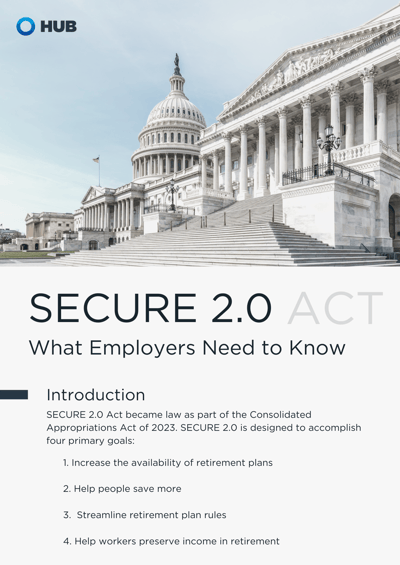It’s finally here! After much back-and-forth, Congress passed the long-awaited SECURE 2.0 just before the close of 2022. This legislation is intended to expand access to retirement plans and increase savings, preserve Americans’ income, and simplify/clarify retirement plan rules. There are over 100 total provisions, so here is a summary of the components you should be aware of:
Effective Immediately / 2023
-
-
- Small immediate financial incentives for contributing to a plan: enables employers to offer immediate financial incentives, such as low-dollar gift cards, to incentivize employee participation in retirement plans.
- Roth employer contributions: employers may (this is optional) now offer their match or profit sharing/nonelective contribution as a Roth contribution.
- Employees may self-certify hardships.
- New exclusions from the 10% early withdrawal penalty: qualified disaster, qualified birth/adoption, terminal illness.
- The required minimum distribution (RMD) age increased to 73 (and in 2033, it will increase again to 75).
-
Effective 2024
-
-
- Roth catch-ups ONLY for high-income earners: employees earning over $145,000 may only make catch-up contributions as Roth contributions.
- No RMDs for Roth assets in retirement plans.
- Employer matching of student loan payments: employers may choose to apply the retirement plan’s matching formula to employees’ student loan payments and deposit the match into the retirement plan, even if the employees are not participating/contributing to the plan.
- Additional exclusions from 10% early withdrawal penalty: emergency expenses (employees may make one withdrawal of up to $1,000 for emergency expenses. The employee can repay the withdrawal within three years and may not make another emergency expense distribution within that three-year period unless already fully repaid) and cases of domestic abuse (lesser of $10,000 or 50% of their vested account balance).
- Increased limit on small balance force-outs: from $5,000 to $7,000.
- Emergency savings “side-car” account linked to a retirement plan: non-highly compensated employees can be automatically enrolled at 3% and save up to $2,500 in this Roth emergency saving account. It can be accessed tax- and penalty-free.
- Automatic portability: employees’ retirement accounts can automatically transfer from their former to their current/next employer.
-
Effective 2025
-
-
- Higher catch-up limits at ages 60, 61, 62, and 63: catch-up limit increased to the greater of $10,000 or 50% more than the “regular” catch-up limit for individuals who have attained age 60 but not age 64 before the end of the calendar year.
- Improving retirement plan access for part-time workers: currently, long-term, part-time employees who work 500+ hours in three consecutive years must be allowed to save in company retirement plans. The new legislation reduces that from three years to two.
- Your plan amendments: plan amendments made to comply with the Act must be adopted by the end of the 2025 plan year (2027 in the case of governmental plans).
-
Effective 2027
-
-
- Saver’s match replaces saver’s credit: in essence, a government/ Treasury match of 50% of retirement plan contributions, up to $2,000 per employee, for low-to-moderate income workers.
-
We hope you find this helpful! If you want more information download our detailed Executive Summary Report. Feel free to reach out with any questions or to learn more.
(This information was put together to educate plan sponsors and is not intended as guidance or tax/legal advice. Each plan has unique requirements and you should consult your attorney or tax advisor for guidance on your specific situation.)
Download Our Executive Summary Report Below

